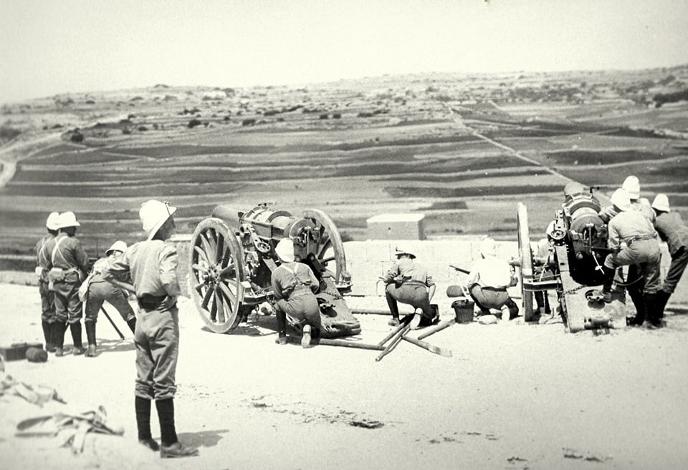MILITARY HISTORY & SITES
The earliest fortifications in and around Mosta date back to the Bronze Age whereby the inhabitants chose high ridges, hills and promontories to establish their settlements upon.
Taking advantage of the natural rise of such sites, these early inhabitants secured any potential breach points by extensive rubble walls.
It is believed that Misrah Ghonoq, where Fort Mosta now stands, constituted such a fortified settlement.
Another example survives at Qala Hill, just outside Mosta.

Qala Hill Bronze Age Fortified Settlement
It appears that the earliest military towers in Malta date back to Punico-Roman times.
Only some ruins of these remain, mostly in the South of the island.
Given the important Roman settlement around the port of Burmarrad and Salina, it is highly probable that such watchtowers were present in Mosta or its vicinity.
About a thousand years later, many villages had adopted the initiative of building towers and fortified residences with lookouts aimed at raising the alarm in case of trouble. Malta was then under constant threat from raiding pirates, smugglers and even better organised forces.
One such structure is known as Torre Cumbo, or Cumbo Tower.
Considered one of the oldest buildings in Mosta, it was reportedly the stronghold of the town during the late Middle Ages.
Torre Cumbo
In 1526 AD Mosta was attacked by Sinan Reis, a Sephardic Jew under the employ of the rising Ottoman Empire, and one of the most notorious corsairs of the time.
Mosta was devastated and 400 of its inhabitants, were taken into slavery. A popular folk legend ballad alleges that a bride being married at Torre Cumbo was among those abducted.

Sinan Reis - The Man behind the Mosta attack of 1526 (1)
The Tower last served as a military outpost in WWII and is presently owned by the Contessa Preziosi, daughter of the late Barone della Quleja.
A small paleo-Christian catacombs may also be found within its grounds.
Another surviving fortified structure is Kaspru's Palace - il-Palazz ta' Kaspru, which is actually a farmhouse despite its namesake. Simple yet sturdy, it was conceived to afford shelter to the people of Mosta from frequent corsair raids and attacks.
In case of a full scale invasion by any external enemy the inhabitants of Mosta and entire region were instructed to seek refuge in Mdina.

Palazz ta' Kaspru (2)
The arrival of the Knights of the Order of St. John, in 1530 AD finally brought the Maltese some military support, but the Order's presence here was a double sided sword, since it further attracted the attention of the Ottomans.
The size and topography of Maltese towns and villages did not make it viable to fortify the majority. Efforts were focused instead on building and improving defences around the grand harbour area.
The only defensive capability across the rest of the island was through a scatter of fortified buildings and towers, the majority of which privately built.
Just overlooking Mosta and a very large section of the island from its perch under Dwerja ridge stood Torre Falka.
Another two towers were established at the other extremity of Mosta at San Pawl tat-Targa (Naxxar). The first was built privately, hence known as Torri Gauci, possibly around the 1540s, while another was built in its immediate vicinity by the Order in the late 1550s.

Torri Gauci - Torri Falka - Torri tal-Kaptan
Malta soon came under attack, in the summer of 1565 AD, in what is known as the Great Siege. The Knights of St. John and the Maltese rallied together to defend their land and lives from a huge Ottoman military force.
A lesser known detail about the siege concerns the first landings of enemy troops in Malta. This did not occur in the Grand Harbour area or South of the island, but rather at Mgarr, through such Bays as Gnejna and Ghajn Tuffieha.
The first skirmish between the opposing forces is recorded as having occurred in this area around May 19th, 1565.
By September is had become clear to the Ottomans that Malta would not break, and relief was on the way from Christian Sicily.
It is believed that one of the last battles of the siege occurred around Torre Falka.
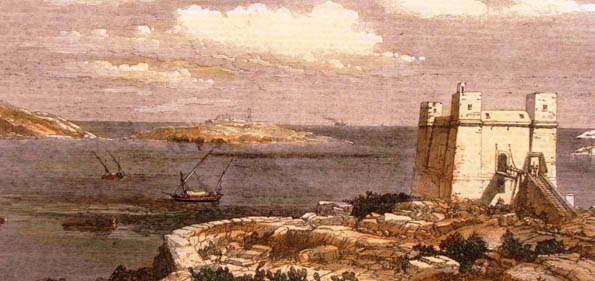
Wignacourt Tower in St. Paul's Bay
Over the next two centuries, an extensive network of coastal towers, batteries, redoubts and entrenchments was built by the Order, but the vicinity of Mdina to the Northern Coast remained a cause of concern.
With Mosta lying directly in between, it was decided to fortify its most vulnerable flanks with the construction of ramparts at Falka Gap and T'Alla u Ommu.
Although the walls did not go all around the town, these fortifications are unique, since no other locality in Malta aside of Mdina, Valletta & the harbour / three cities were afforded such elaborate defences. (3)
Falka Gap Fortifications: A - Torre Falka. B - Redoubt. C - Apex. D - Demi-Bastion.
The Falka Gap lines date from the 1720s, and were completed by 1731. By the 18th century, the Order's coffers had been severely depleted so these defences, like most of the coastal batteries and redoubts, were left unmanned.
The quality of the stone used for many of these latter period military structures also seems to have been inferior. These factors and the resulting lack of maintenance led to a rapid deterioration. Consequently, the Falka & Targa Lines and most of the Order's fortifications built through the 1700s fell to ruin.
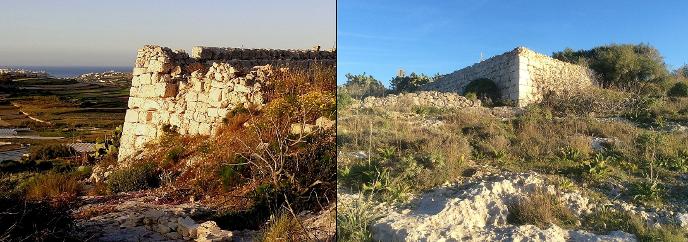
Surviving demi-bastion at Falka Gap & similar element at San Pawl tat-Targa
The effectiveness of the Mosta entrenchment was never challenged by war, but after Malta changed hands from the Order to the French, and subsequently to the British, it served as an inspiration for the eventual building of the Victoria Lines through the 1880s.
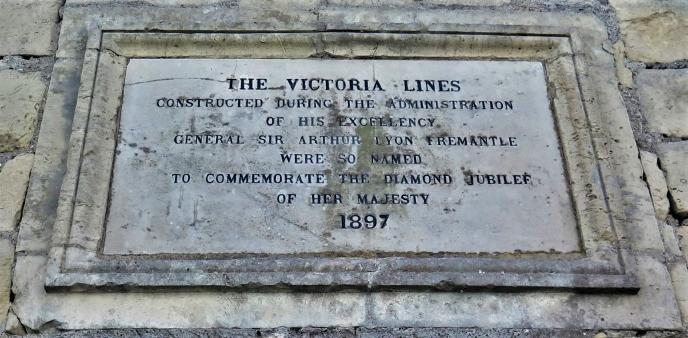
Commemorative Plaque
An impressive military and architectural feat with a beautiful wide angle view of the low land that sprawls beyond the geographic fault.
Running across the width of the island it was fortified by a series of forts and batteries interconnected together with long stretches of defensive walls.
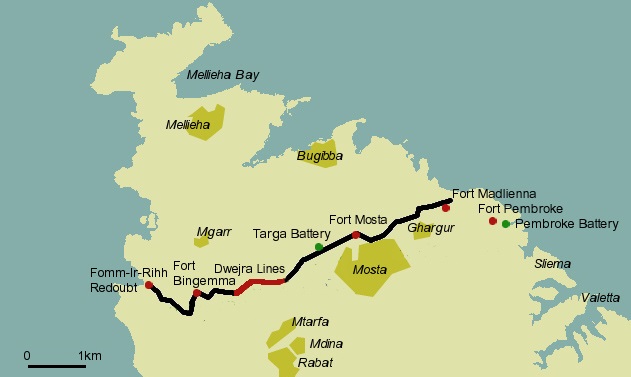
Victoria Lines - General Layout
This idea was to take advantage of the natural fault and to serve as a front line in case of an invasion on the northern coast since the geographic and topographic character of the northern part of the island disallowed long term defence in this area.
The central hub of the Lines is at Mosta, where a large fort was built at Misrah Ghonoq, close to the commemorative plaque marking the project's completion. Walking straight towards Falka Gap, one finds a secondary fortification known as Targa Battery.

Fort Mosta & Targa Battery
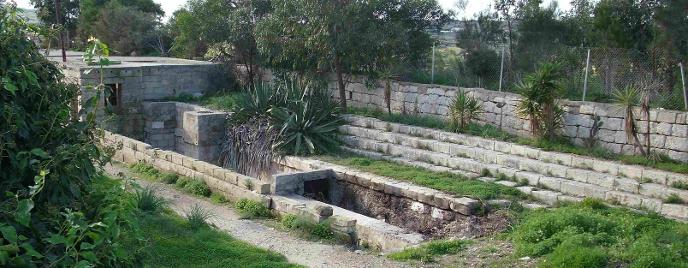
Two new sets of barracks were built at Mtarfa and St. Andrews as part of the logistic setup and several auxiliary structures were added to the immediate rear of the Lines.
These included Searchlight Positions at Dwejra, a Powder Room in Mosta, and a series of new Bridges to facilitate access.
More details and images in the link below
POSTWAR INSTALLATONS
Civil Defence Centre f’Misrah Ghonoq u
ix-Xelter Nukleari tan-Nato ta' tahtu
Designed by http://www.mitchinson.net
